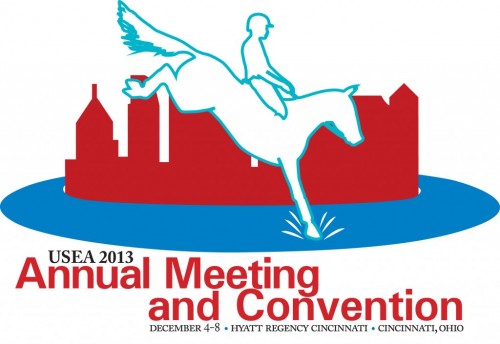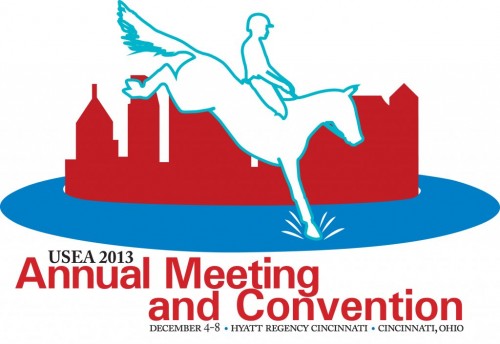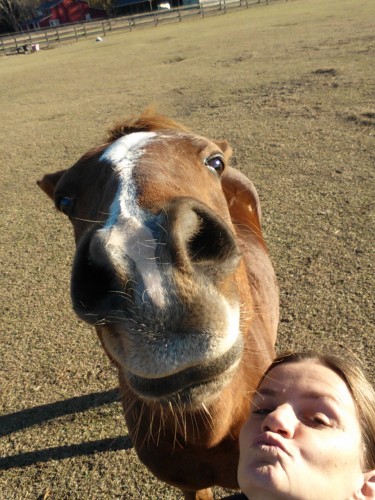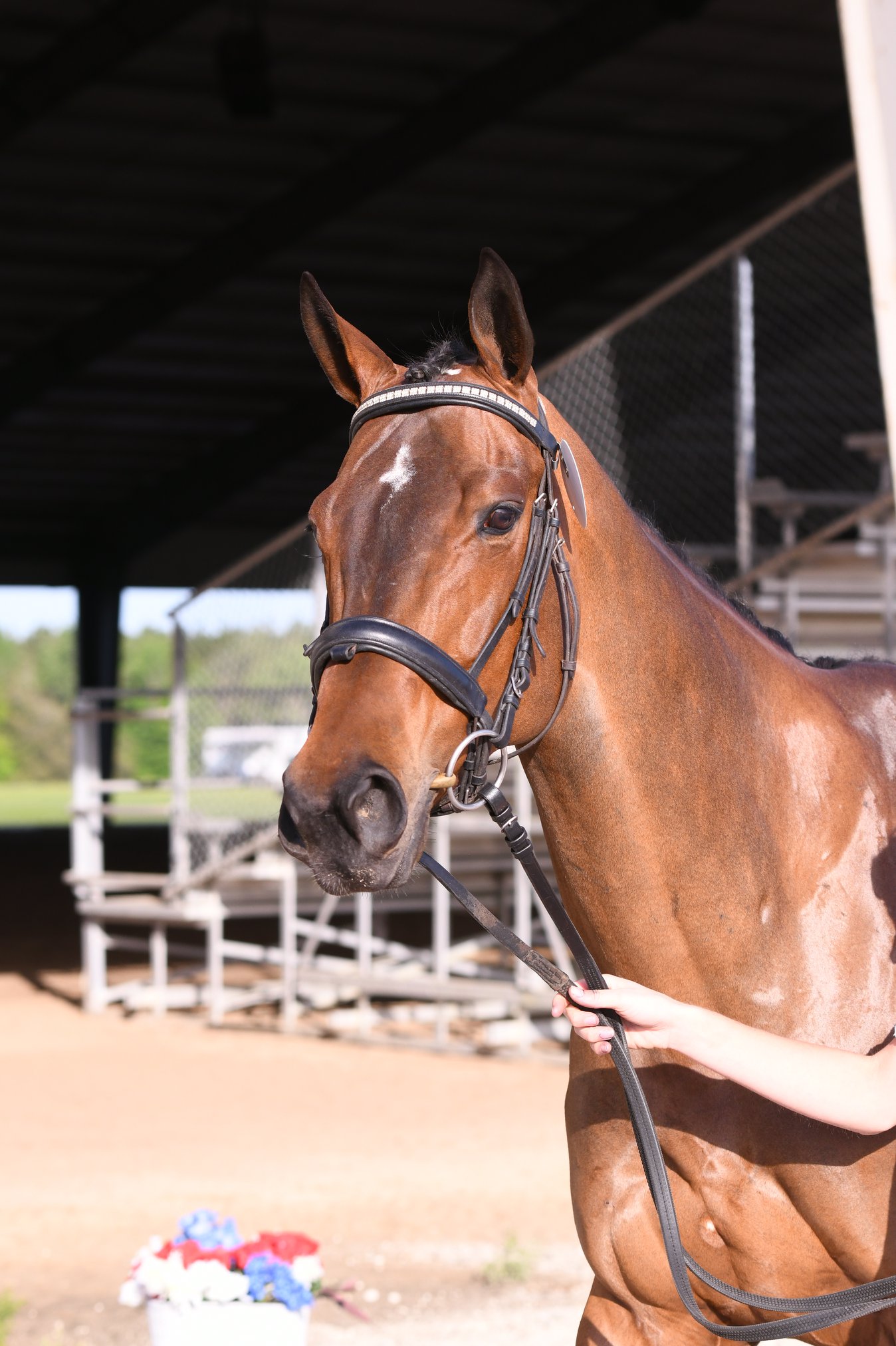
Greetings from the 2013 USEA Convention and Annual Meeting in Cincinnati, Ohio! I caught an early morning flight and arrived in time to sit in on the first of Coach David O’Connor’s High Performance sessions, which focused on what happened this year, as well as how the program fared on goals set at least year’s Convention. All my notes are written in David’s voice, so feel free to read along using your best DOC impression.
Looking Back at 2013 Goals
1. Assess riders, horses, different programs, see what’s going on in the country to make long-range and short-range plans.
2. Product 70% dressage scores
3. Create buy-in for riders to believe in the program
4. Create a system of owner recognition
5. Create a team atmosphere and a sense that we’re all going through this together.
6. Continental push to travel to different countries instead of just using England as has typically been the case.
7. Explore logistics of how we do these trips, where we train, where we stay, where we fly into, etc.
8. Be competitive in the European CCIs
9. Create a new vet/farrier program that is more proactive instead of reactive, i.e. evaluating horses at training sessions and not just after competitions, as well as having better conversations between riders, owners and vets
“I believe we have all the talent we need to win medals. That is a core belief of mine. None of that has changed this year.”
Balancing Your Business
For riders with very large programs — time management is still a huge issue. How do you manage your time? Not jus time you ride your horses but have enough time to think about riding your own horses instead of getting caught as the hamster on the treadmill you end up gong and going and going and you end up losing the details. Soundness to stable management to training. That is a continued covnersation.There is no one easy answer.
How do you balance the business side and how do you balance the competitive side? In every country, it’s a bit different. It’s very different in the U.S. with a country that’s 3,000 miles wide and 2,000 miles high. Here, we have an education system, since you take your students everywhere you go, as opposed to being a competitive system like it is in Europe.
Investing in the Next Generation
I think people are hungry for wanting to do well and be able to put their foot on the map. I want to continue that investment in your education and in the international competitions.The immediate results of that are not always going to be apparent right away. In investing into the next generation of riders, we’re not going to see some of those goals being achieved for two to three years.
That was a mistake we made before — not investing in the next generation. If we only bet on the upper-level riders, we get in trouble seven or eight years from now. It’s a mistake to just bet on the top riders. They will be bet on too. But we have to bet on the next generation.
We Need Strings
I think we’re short of top horses as a group. We have individual horses that are fantastic and as good as anywhere in the world. Nobody that I know across the whole country has a string — not one. And I can’t look at anybody and say that I would bet on and say they were going to be on every team in the next 10 years.
I believe that’s one of the people we’re looking for — to make sure we do have riders who will be on multiple teams in a row on multiple horses because their program is strong, they have a system of bringing up horses underneath them, and they have a system that’s working. I don’t know of anybody who has that whole system working. And I think that’s a thing we’ll keep working toward. The top riders that are going to fight for it are going to make it happen.
Under 25/Under 18
I think the Under 25 program was very successful this year. They had clinics on the West Coast and East Coast, access to coaching at competitions and through phone calls. It created a support system. We start the Under 18 program on Dec. 27 with a week-long training session. Similarly, we have to tweak how these riders are recognized and how they’re found. We need to be better at that next year — determining how they’re identified. Hopefully next year, the program will be big enough to have training sessions on the West Coast and East Cost.
Need for an Assistant Coach
I would like to keep the Under 25 and Under 18 programs for the next couple of years, but I really do believe we should work toward having a separate coach. I believe there needs to be a separate coach at some point that we could fundraise for, and we’ve already started talking about fundraising for a coach who could give a 10-year commitment to handle the Under 25 and Under 18 programs. We’re still several steps from that point, but that’s something I think would be useful in order to make sure whoever the head coach is has more time to deal with just the High Performance riders and not be spread too thin.
I want to make sure that in the job that I was hired for that I actually have enough time to back off and take a look at the bigger picture. That’s the goal in starting the Assistant Coach program in the coming years.
DOC’s Travel Stats
On the road 255 days this year
Took 75 flights
Taught 50 days of training sessions
That’s in addition to work at private farms and competitions.
Evaluating 2013 Performances
The dressage work is going in the right direction. I really do see improvement, but not a lot of comfort in the competitive ring. As we talked about last year, technique leads to theory, theory leads to instinct. What you’re seeing in the training sessions and in warm up is leading to experimenting in the competition ring, so it’s going in the right direction.
On the day before dressage in Europe, I can’t tell you how many times I was really excited before the competition. But the work didn’t always transfer over to the next day. As people become more comfortable with producing that work in the box, we’ll see more results.
We accomplished the goal of creating buy-in. I believe that everyone is starting to move in the right direction and come together. The people who fight the hardest are the most aggressive who produce results that are repeatable, repeatable, repeatable. Those are the people we are looking for. Those are going to be the Olympic teams. And we’ve gone to four riders on teams now. It’s a fight. It’s going to be a fight among you and us all together, and then we all celebrate the four people who stand on the podium together.
Joanie Morris is a game changer. <insert large round of applause for Joanie> Owners are getting a level of service they’v never had before and a communication level they’v never had before. That’s a huge big part of the program. Bryn Wells has been unbelievably organized. <insert round of applause for Bryn> A lot of that communication with owners is coming from her office. The combination of the two of them has been amazing and has made my job easier.
Looking at European CCIs
We came close to winning one CCI3* and were in the game for a CCI4*. At European CCIs, we had seven top-10 finishes and four in the top 20. I really do believe we’re going to win a European CCI very soon.
New Vet/Farrier System
The new vet team
Mark Revenaugh — leading vet team
Duncan Peters — evaluating vet
Susan Johns — U.S. traveling vet
Tim Randle — England-based vet
Marc Koene — Continent-based vet
Dr. Mieke Does — Vet assistant and physiotherapist
We kept some horses out of injury by being more aggressive about physical therapy. That will benefit us all, especially as we look at being more proactive instead of reactive to physical therapy as the new medication rules go into effect. The proactive side of the vet program is huge.
Looking Ahead to WEG, Pan Ams, Olympics
I believe it’s going to take three years before this system hits on all cylinders. That takes us up to the 2016 Olympic Games. Last year, I said the Games feel really close, and now we’re one year closer. Have an open mind. Don’t be in a tunnel. See what’s happening around you.
The Olympic Games are different than the Worlds. The World Games to me will be a cross-country dominant competition. It’s a hilly piece of terrain. And it’s a Pierre Michelet course, which means a lot of jumping efforts. It’s very technical in its own way. The Olympics will be different even though Pierre is also the course designer there. We’ve already been on the site and seen it’s not that hilly. There is one big hill that’s used about one-third of the way through course.
The Olympics will be back to double show jumping for two medals. Team medals are won on the first round of show jumping. That competition is going to be most likely going to have a 10-minute cross-county course, just like most of the Olympic courses in the past. I don’t think it will be as cross-country dominant as the WEG. Dressage and show jumping will become more important. Are these the same horses (that will be suited for both competitions)? Some may be and some may not. Keep in mind which competition you’re getting ready for.
Hopefully we will not need to use the 2015 Pan American Games as a qualifier for Rio. I am counting on getting qualified next year at the WEG; the top six countries qualified for the Olympic Games. Otherwise, you have to qualify at your regional championships, which is the Pan Ams. The Pan Ams will be a mixture of two- and three-star horses. If you have 6- and 7-year-olds, start thinking about preparing for the Pan Ams as a step toward other things.
Goals for 2014
60% of riders under 45 in dressage
75% clear on cross country
60% clear on show jumping
Team medals depend on clear rounds. I want to emphasize 45. If we get 45 as the number, that’s the first step. And you end up on a 45, I can guarantee you can get one of the top two medals as a team. We’re absolutely behind on the dressage, but we have to bring riders home clear on cross country too. We’ve had very good performances in the different phases, but we need results where all three phases come together.


























































